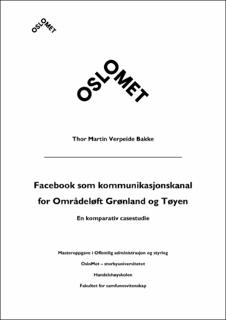| dc.description.abstract | The thesis presents a mapping of how the public sector uses Facebook as a communication channel in connection with the urban intervention at Grønland and Tøyen. This urban intervention is linked to a geographically delimited area in Oslo's inner east which was incorporated during the area investment in the inner east in 2019 (Oslo kommune, 2020, s. 4-6). The thesis is associated with the DEMUDIG project. DEMUDIG stands for "democratic urban development in the digital age" and is a three-year (2018-2021) interdisciplinary project that researches whether digital platforms promote participatory democracy.
The following problem statement is formulated for the thesis:
How does the public sector use Facebook as a communication channel for the urban intervention at Grønland and Tøyen?
The data material used consists of qualitative and quantitative data from primary and secondary sources. Seven in-depth interviews and three document studies make up the qualitative part of the data material, while a data set consisting of 853 observations of published posts on relevant Facebook pages makes up the quantitative part. The problem is elucidated by analyzing the data material considering theoretical concepts within communication strategy in social media, categorization of content, indexing of engagement and adoption of social media.
The findings indicate that the public sector's use of Facebook as a communication channel for the urban intervention at Grønland and Tøyen can be most closely linked to representation as a communication strategy, but with aspects that point in the direction of civic engagement as a communication strategy. Furthermore, I find that ‘culture, leisure and the local environment’ is the topic that most published posts deal with. The findings also show that reactions in the form of likes are the most prominent form of engagement and that a higher level of engagement occurs when the case becomes concrete and specific. The analysis further shows that the public sector's use of Facebook as a communication channel for the urban intervention at Grønland and Tøyen is on its way into phase three of the adoption model, but with significant shortcomings in phase one and phase two that sets limits. Lack of internal knowledge, regular competence building and interest as well as lack of employees who only have social media as a task is especially important to point out in this context.
The widespread lack of internal knowledge about the use of Facebook, as several informants point out, is related to public sector shortcomings in the implementation of Facebook. This can further be linked to why representation as a communication strategy is most prominent. If sufficient knowledge does not exist internally, it will also not be possible to utilize the tool's functionalities in a sufficient way that further leads to limited form of communication and citizen involvement.
Furthermore, there is some discrepancy between how public sector have planned to use Facebook as a communication channel, how they experience that they use it and how they actually use it. This indicates a need for better mapping and follow-up of established plans. | en_US |
